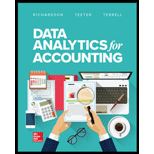
Concept explainers
Identify the appropriate answer for the given statement from the given choices.
Answer to Problem 1MCQ
Option d. Test data is a set of data used to assess the degree and strength of a predicted relationship.
Explanation of Solution
Justification for correct and incorrect answer:
a.
Training data: This is not the correct choice as the training data refers to the existing data which have been pre-evaluated manually and these data have been assigned a class. This is used as a model which can predict whether the similar default can happen in the future or not on the basis of the existing data.
b.
Unstructured data: This option is incorrect option because unstructured data refers to the data which is not there in proper format and which is not arranged in a pre-defined manner. The unstructured data may contain the facts and details which are vital. But the unstructured data is not the set of data used to assess the degree and strength of a predicted relationship.
c.
Structured data: This option is incorrect as the structured data which are organized and remain in a fixed width with a record or a file. Such data are embedded in a relational database or spreadsheet and are quickly searchable by the search algorithms. These data are not used to assess the degree and strength of a predicted relationship.
d.
Test data: This is the correct option because it is the set of existing data which is used for evaluation of the data model. The classification
Want to see more full solutions like this?
Chapter 3 Solutions
Data Analytics For Accounting
- no aiOne company might depreciate a new computer over three years while another company might depreciate the same model computer over five years...and both companies are right. True Falsearrow_forwardno ai An asset's useful life is the same as its physical life? True Falsearrow_forwardno ai Depreciation Expense reflects an allocation of an asset's original cost rather than an allocation based on the economic value that is being consumed. True Falsearrow_forward
- The purpose of depreciation is to have the balance sheet report the current value of an asset. True Falsearrow_forwardDepreciation Expense shown on a company's income statement must be the same amount as the depreciation expense on the company's income tax return. True Falsearrow_forwardDont use AI Give soln.arrow_forward
 Auditing: A Risk Based-Approach (MindTap Course L...AccountingISBN:9781337619455Author:Karla M Johnstone, Audrey A. Gramling, Larry E. RittenbergPublisher:Cengage Learning
Auditing: A Risk Based-Approach (MindTap Course L...AccountingISBN:9781337619455Author:Karla M Johnstone, Audrey A. Gramling, Larry E. RittenbergPublisher:Cengage Learning Accounting Information SystemsAccountingISBN:9781337619202Author:Hall, James A.Publisher:Cengage Learning,
Accounting Information SystemsAccountingISBN:9781337619202Author:Hall, James A.Publisher:Cengage Learning, Intermediate Accounting: Reporting And AnalysisAccountingISBN:9781337788281Author:James M. Wahlen, Jefferson P. Jones, Donald PagachPublisher:Cengage Learning
Intermediate Accounting: Reporting And AnalysisAccountingISBN:9781337788281Author:James M. Wahlen, Jefferson P. Jones, Donald PagachPublisher:Cengage Learning Cornerstones of Cost Management (Cornerstones Ser...AccountingISBN:9781305970663Author:Don R. Hansen, Maryanne M. MowenPublisher:Cengage LearningPrinciples of Accounting Volume 2AccountingISBN:9781947172609Author:OpenStaxPublisher:OpenStax College
Cornerstones of Cost Management (Cornerstones Ser...AccountingISBN:9781305970663Author:Don R. Hansen, Maryanne M. MowenPublisher:Cengage LearningPrinciples of Accounting Volume 2AccountingISBN:9781947172609Author:OpenStaxPublisher:OpenStax College Auditing: A Risk Based-Approach to Conducting a Q...AccountingISBN:9781305080577Author:Karla M Johnstone, Audrey A. Gramling, Larry E. RittenbergPublisher:South-Western College Pub
Auditing: A Risk Based-Approach to Conducting a Q...AccountingISBN:9781305080577Author:Karla M Johnstone, Audrey A. Gramling, Larry E. RittenbergPublisher:South-Western College Pub





